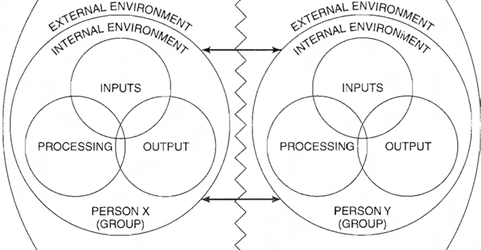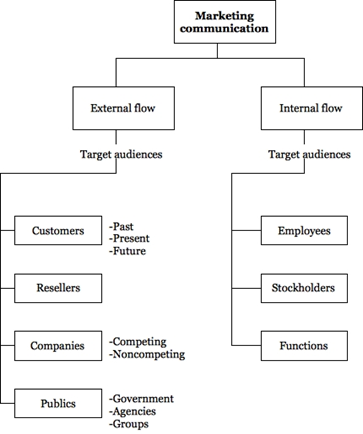8.3: How we communicate
- Page ID
- 21380
\( \newcommand{\vecs}[1]{\overset { \scriptstyle \rightharpoonup} {\mathbf{#1}} } \)
\( \newcommand{\vecd}[1]{\overset{-\!-\!\rightharpoonup}{\vphantom{a}\smash {#1}}} \)
\( \newcommand{\id}{\mathrm{id}}\) \( \newcommand{\Span}{\mathrm{span}}\)
( \newcommand{\kernel}{\mathrm{null}\,}\) \( \newcommand{\range}{\mathrm{range}\,}\)
\( \newcommand{\RealPart}{\mathrm{Re}}\) \( \newcommand{\ImaginaryPart}{\mathrm{Im}}\)
\( \newcommand{\Argument}{\mathrm{Arg}}\) \( \newcommand{\norm}[1]{\| #1 \|}\)
\( \newcommand{\inner}[2]{\langle #1, #2 \rangle}\)
\( \newcommand{\Span}{\mathrm{span}}\)
\( \newcommand{\id}{\mathrm{id}}\)
\( \newcommand{\Span}{\mathrm{span}}\)
\( \newcommand{\kernel}{\mathrm{null}\,}\)
\( \newcommand{\range}{\mathrm{range}\,}\)
\( \newcommand{\RealPart}{\mathrm{Re}}\)
\( \newcommand{\ImaginaryPart}{\mathrm{Im}}\)
\( \newcommand{\Argument}{\mathrm{Arg}}\)
\( \newcommand{\norm}[1]{\| #1 \|}\)
\( \newcommand{\inner}[2]{\langle #1, #2 \rangle}\)
\( \newcommand{\Span}{\mathrm{span}}\) \( \newcommand{\AA}{\unicode[.8,0]{x212B}}\)
\( \newcommand{\vectorA}[1]{\vec{#1}} % arrow\)
\( \newcommand{\vectorAt}[1]{\vec{\text{#1}}} % arrow\)
\( \newcommand{\vectorB}[1]{\overset { \scriptstyle \rightharpoonup} {\mathbf{#1}} } \)
\( \newcommand{\vectorC}[1]{\textbf{#1}} \)
\( \newcommand{\vectorD}[1]{\overrightarrow{#1}} \)
\( \newcommand{\vectorDt}[1]{\overrightarrow{\text{#1}}} \)
\( \newcommand{\vectE}[1]{\overset{-\!-\!\rightharpoonup}{\vphantom{a}\smash{\mathbf {#1}}}} \)
\( \newcommand{\vecs}[1]{\overset { \scriptstyle \rightharpoonup} {\mathbf{#1}} } \)
\( \newcommand{\vecd}[1]{\overset{-\!-\!\rightharpoonup}{\vphantom{a}\smash {#1}}} \)
\(\newcommand{\avec}{\mathbf a}\) \(\newcommand{\bvec}{\mathbf b}\) \(\newcommand{\cvec}{\mathbf c}\) \(\newcommand{\dvec}{\mathbf d}\) \(\newcommand{\dtil}{\widetilde{\mathbf d}}\) \(\newcommand{\evec}{\mathbf e}\) \(\newcommand{\fvec}{\mathbf f}\) \(\newcommand{\nvec}{\mathbf n}\) \(\newcommand{\pvec}{\mathbf p}\) \(\newcommand{\qvec}{\mathbf q}\) \(\newcommand{\svec}{\mathbf s}\) \(\newcommand{\tvec}{\mathbf t}\) \(\newcommand{\uvec}{\mathbf u}\) \(\newcommand{\vvec}{\mathbf v}\) \(\newcommand{\wvec}{\mathbf w}\) \(\newcommand{\xvec}{\mathbf x}\) \(\newcommand{\yvec}{\mathbf y}\) \(\newcommand{\zvec}{\mathbf z}\) \(\newcommand{\rvec}{\mathbf r}\) \(\newcommand{\mvec}{\mathbf m}\) \(\newcommand{\zerovec}{\mathbf 0}\) \(\newcommand{\onevec}{\mathbf 1}\) \(\newcommand{\real}{\mathbb R}\) \(\newcommand{\twovec}[2]{\left[\begin{array}{r}#1 \\ #2 \end{array}\right]}\) \(\newcommand{\ctwovec}[2]{\left[\begin{array}{c}#1 \\ #2 \end{array}\right]}\) \(\newcommand{\threevec}[3]{\left[\begin{array}{r}#1 \\ #2 \\ #3 \end{array}\right]}\) \(\newcommand{\cthreevec}[3]{\left[\begin{array}{c}#1 \\ #2 \\ #3 \end{array}\right]}\) \(\newcommand{\fourvec}[4]{\left[\begin{array}{r}#1 \\ #2 \\ #3 \\ #4 \end{array}\right]}\) \(\newcommand{\cfourvec}[4]{\left[\begin{array}{c}#1 \\ #2 \\ #3 \\ #4 \end{array}\right]}\) \(\newcommand{\fivevec}[5]{\left[\begin{array}{r}#1 \\ #2 \\ #3 \\ #4 \\ #5 \\ \end{array}\right]}\) \(\newcommand{\cfivevec}[5]{\left[\begin{array}{c}#1 \\ #2 \\ #3 \\ #4 \\ #5 \\ \end{array}\right]}\) \(\newcommand{\mattwo}[4]{\left[\begin{array}{rr}#1 \amp #2 \\ #3 \amp #4 \\ \end{array}\right]}\) \(\newcommand{\laspan}[1]{\text{Span}\{#1\}}\) \(\newcommand{\bcal}{\cal B}\) \(\newcommand{\ccal}{\cal C}\) \(\newcommand{\scal}{\cal S}\) \(\newcommand{\wcal}{\cal W}\) \(\newcommand{\ecal}{\cal E}\) \(\newcommand{\coords}[2]{\left\{#1\right\}_{#2}}\) \(\newcommand{\gray}[1]{\color{gray}{#1}}\) \(\newcommand{\lgray}[1]{\color{lightgray}{#1}}\) \(\newcommand{\rank}{\operatorname{rank}}\) \(\newcommand{\row}{\text{Row}}\) \(\newcommand{\col}{\text{Col}}\) \(\renewcommand{\row}{\text{Row}}\) \(\newcommand{\nul}{\text{Nul}}\) \(\newcommand{\var}{\text{Var}}\) \(\newcommand{\corr}{\text{corr}}\) \(\newcommand{\len}[1]{\left|#1\right|}\) \(\newcommand{\bbar}{\overline{\bvec}}\) \(\newcommand{\bhat}{\widehat{\bvec}}\) \(\newcommand{\bperp}{\bvec^\perp}\) \(\newcommand{\xhat}{\widehat{\xvec}}\) \(\newcommand{\vhat}{\widehat{\vvec}}\) \(\newcommand{\uhat}{\widehat{\uvec}}\) \(\newcommand{\what}{\widehat{\wvec}}\) \(\newcommand{\Sighat}{\widehat{\Sigma}}\) \(\newcommand{\lt}{<}\) \(\newcommand{\gt}{>}\) \(\newcommand{\amp}{&}\) \(\definecolor{fillinmathshade}{gray}{0.9}\)Because communication is such an integral part of effective marketing, it is important that we provide a basic understanding of its process. Our starting point is a basic definition of human communication: a process in which two or more persons attempt to consciously or unconsciously influence each other through the use of symbols or words in order to satisfy their respective needs.
Basic elements of communication
The basic elements within any communication system are depicted in Exhibit 21. It includes two or more people or organizations called communicators. The underlying assumption of this model is that all communications (dialogue) are continuous. This factor suggests that we are constantly and simultaneously in the role of communicator and receiver. Each communicator is composed of a series of subsystems (i.e. inputs, outputs, processing). The input subsystem permits the communicator to receive messages and stimulus from outside as well as from the other communicator. It involves the reception of light, temperature, touch, sound and, odors via our eyes, skin, ears, nose, and taste buds. These stimuli are intimately evaluated through a process called perception. Thus, we input and perceive advertising messages, a coupon, the appearance and words of a salesperson, and so forth.3
The processing subsystem of a communicator includes all thought processes. As we process, we generate, organize, and reflect on ideas in response to the stimuli received. This entire process is determined not only by the stimuli just received, but also by all stimuli ever received, such as past experiences, education, health, genetics, and all other factors in our environment. Some people clearly process the humor in the Pepsi-Cola ads better than others.
The output subsystem includes the messages and other behaviors produced by the communicator. These include nonverbal messages, verbal messages, and other physical behaviors. All of these become input (feedback) for other people and can have both intentional and unintentional effects on them.

Friend, parent, boss, client, or customer are just some of the roles we may portray in any communication process. The nature of the role directly affects the nature of communication. We communicate quite differently with our boss than we do with close friends. People who have known each other for a long time often devise their own communication system, which may include lots of nonverbal signals.
Finally, the communication system exists within an environment. The environment is everything internal and external to the communication system that can affect the system (family, school, competing advertisements, etc.). Each of the factors within the environment interacts with the communication system to a different degree. Because communication systems are open to the influence of the total environment, we can never analyze a communication event from only the point of view of the people who seem obviously involved. Everything may affect communication, positively or negatively. The latter factors may alter or distort inputs, outputs, or processing and are called interference. Interference can be generated internally (e.g. fear, love, prejudice) or externally (e.g. noise, weather, physical appearance).
Capsule 16: Review
|
• The primary role of IMC is to systematically evaluate the communication needs and wants of the buyer and, based on that information, design a communication strategy that will: provide answers to primary questions of the target audience; facilitate the customer's ability to make correct decisions; and increase the probability that the choice they make will most often be the brand of the information provider. • Marketing communications is defined as a message delivery system that includes all the identifiable efforts on the part of the seller that are intended to help persuade buyers to accept the seller's message and store it in retrievable form. • The four components that make up marketing communication are: advertising, sales promotion, public relations, and personal selling. • The basic objectives of marketing communication are to: communicate, convince, and compete. • The elements of human communication include: • the processing subsystem • the output subsystem • the nature of the role • the environment • There are four types of communication systems: • interpersonal • organizational • public • mass |
Types of communication systems
There are several types of communication systems, classified depending on the level of contact between communicators and the ability to respond to feedback.
Interpersonal communication systems
At the basic level of interpersonal communication systems is the dyadic context. A dyad consists of two people, or two major subsystems. Personal selling falls under this heading.
Organizational communication systems
The organizational communication context represents a much more complex system than interpersonal communication. Examples include a bank, a factory, a retail store, or the government attempting to communicate with one another. These systems include a large collection of subsystems, all organized around a common goal(s). Interactive technology has changed these types of systems in a dramatic way.
Public communication systems
This type of system involves communication usually from one person to a large group of people. Although everyone affects everyone else to some degree in every communication system, in a public communication context, such as a speech from a politician to people standing behind a platform of a campaign train, the speaker does most of the talking.
Mass communication systems
The mass communication context exists when a person/organization is communicating indirectly with a large group of people and there is even less opportunity for people to interact freely with one another and to mutually affect one another. Advertising and public relations are such mass communications.
Marketing communications
While all communication includes the same basic components depicted in Exhibit 21, marketing communication differs somewhat in two respects. First, the intent of marketing communications is to present a persuasive message, which reinforces the total offer made by the marketer. Essentially, all marketing communication attempts to create uniqueness in the mind of the target audience.
Second, marketing communication can be divided into two flows (i.e. internal and external), which are directed at different target audiences. This necessitates different communication strategies, which, never the less, must be
compatible. A company cannot be telling a customer one story and stockholders another. The flow of marketing
communication is depicted in Exhibit 22.
 Exhibit 22: The flow of marketing communication
Exhibit 22: The flow of marketing communication


